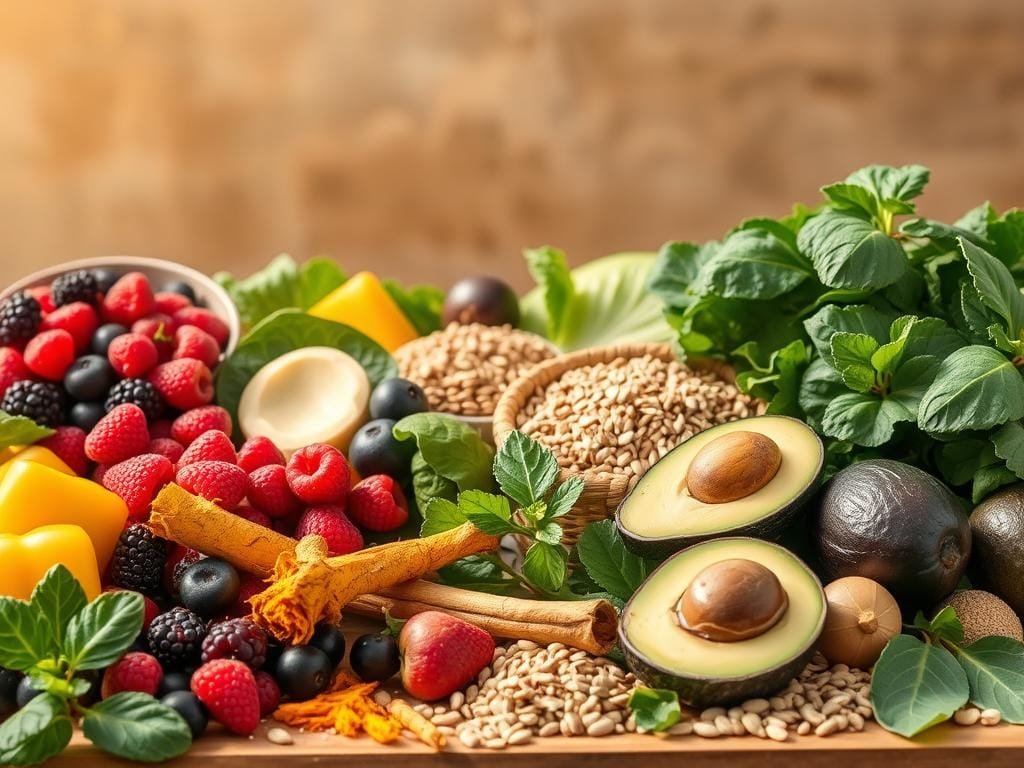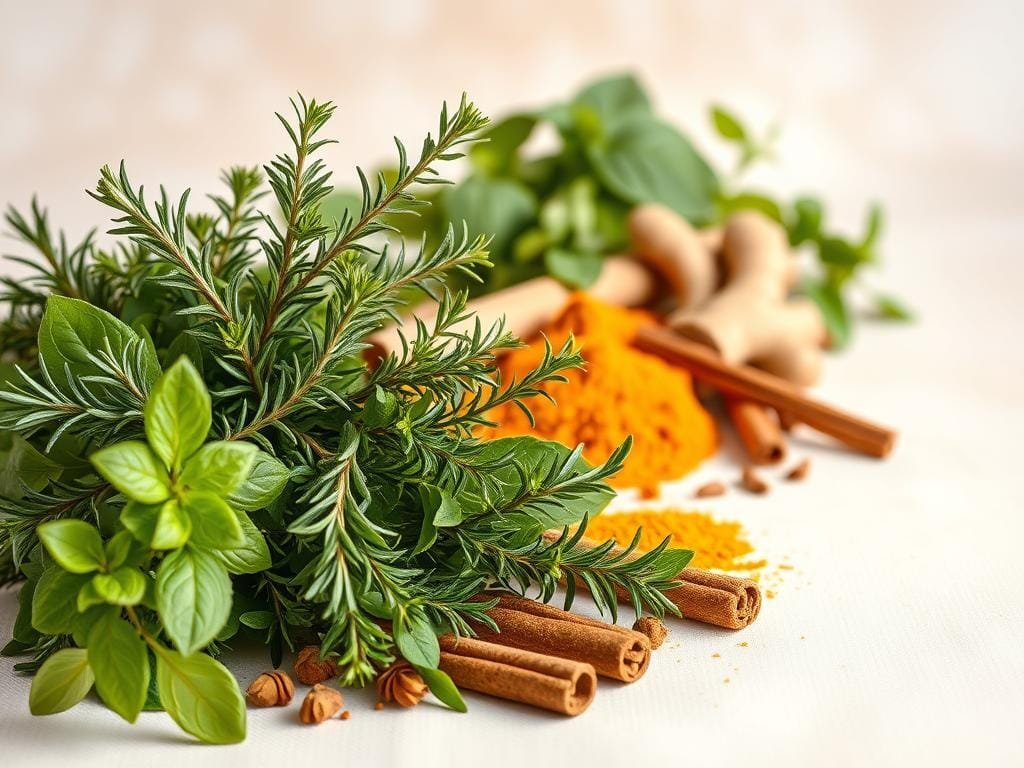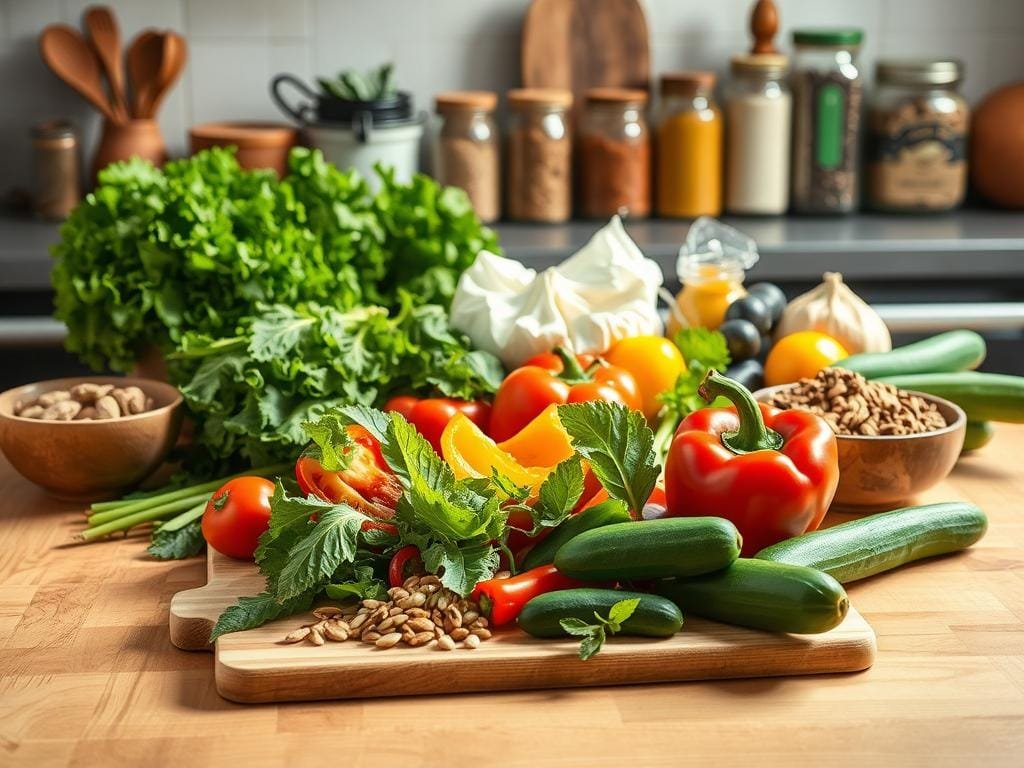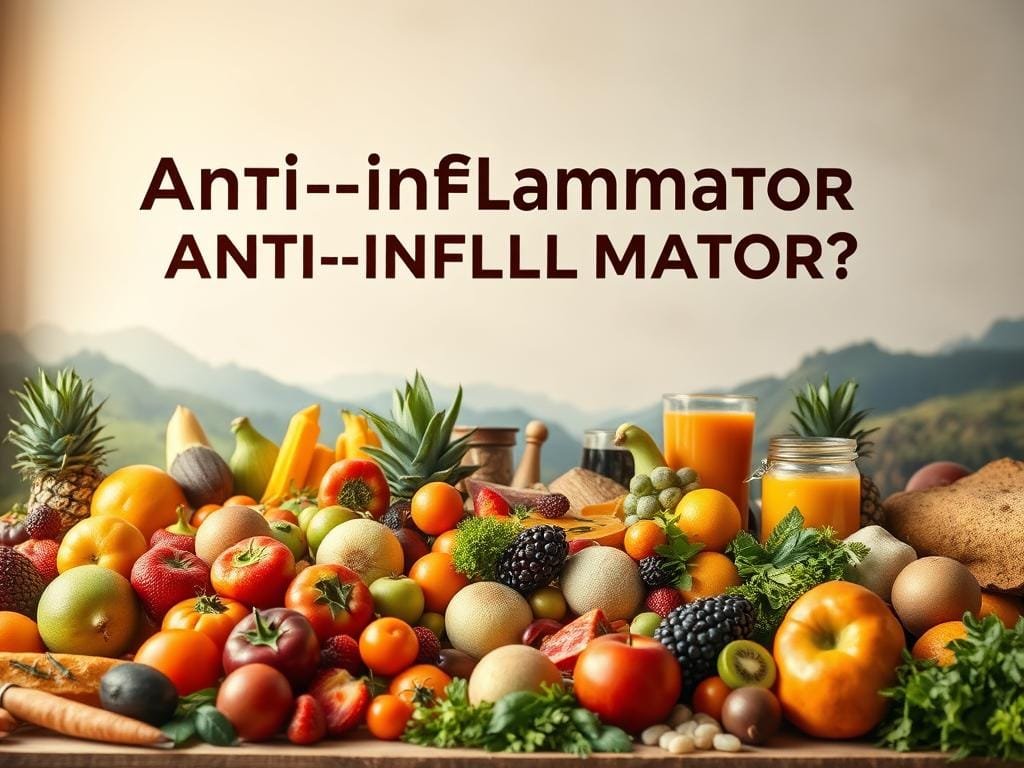Chronic inflammation is a big health problem worldwide. A bad diet can make it worse, raising the risk of heart disease, diabetes, and some cancers. But, an anti-inflammatory diet can help. Eating foods full of antioxidants, omega-3s, and other nutrients can lower inflammation and improve health.
Studies show that foods like fatty fish, berries, and leafy greens fight inflammation well. Learn more about these foods on Healthline. By choosing the right foods, you can control your health and lower disease risks. For healthy recipes to start, check out Boost Healthy Life.
Table of Contents
Key Takeaways
- Incorporating whole foods into your diet can help reduce inflammation.
- Foods rich in antioxidants and omega-3 fatty acids have anti-inflammatory properties.
- A healthy diet can help mitigate the risk of chronic diseases like heart disease and diabetes.
- Making informed dietary choices is key for overall well-being.
- An anti-inflammatory diet can be a powerful tool in promoting overall health.
Understanding Inflammation and Its Impact on Health
Inflammation is how your body reacts to harm and heals itself. It’s a natural response to injury, infection, or other threats. Knowing about inflammation helps you understand your body’s defense.
What Is Inflammation?
Inflammation is when your body’s white blood cells and other parts work to protect you. It’s a healing mechanism that fights off infections. Acute inflammation is short-term and usually goes away once the cause is fixed.
Chronic inflammation lasts a long time and can cause health problems. Knowing the difference between acute and chronic inflammation is key to managing it well.
Types of Inflammation
There are two main types of inflammation: acute and chronic. Acute inflammation is a quick response to injury or infection, marked by redness, swelling, warmth, and pain. It’s a protective response that fades once the cause is gone.
- Acute Inflammation: Short-term, resolves once the cause is addressed.
- Chronic Inflammation: Long-term, can lead to health issues if not managed.
Symptoms of Chronic Inflammation
Chronic inflammation can show up in many ways, making it hard to spot. Symptoms include constant tiredness, joint pain, skin issues, and digestive problems. If you notice these signs, seeing a doctor is important for a correct diagnosis and treatment.
| Symptom | Description |
|---|---|
| Fatigue | Persistent feeling of tiredness or lack of energy. |
| Joint Pain | Aching or stiffness in the joints. |
| Skin Issues | Rashes, acne, or other skin problems. |
| Digestive Problems | Bloating, abdominal pain, or changes in bowel movements. |
Dr. Andrew Weil, a well-known integrative medicine expert, said,
“Chronic inflammation is a major factor in many diseases, including heart disease, cancer, and Alzheimer’s disease.”
Benefits of an Anti-Inflammatory Diet
An anti-inflammatory diet is a natural way to lower chronic inflammation and boost your health. By adding foods that fight inflammation, you can see big health gains.
Improved Overall Health
Eating foods like fruits, veggies, and healthy fats can make you healthier. These foods are full of antioxidants and nutrients that fight inflammation. For example, olive oil, certain berries, fruit, vegetables, spices, and fish can help lower chronic inflammation.

Reduced Risk of Chronic Diseases
Chronic inflammation is connected to diseases like heart disease, diabetes, and some cancers. An anti-inflammatory diet can lower your risk of these diseases. For more info on diet and chronic diseases, check out this resource.
| Disease | Inflammation Link | Dietary Impact |
|---|---|---|
| Heart Disease | Chronic inflammation can lead to atherosclerosis. | Anti-inflammatory diet can help reduce risk. |
| Diabetes | Inflammation affects insulin sensitivity. | Diet rich in anti-inflammatory foods can improve insulin sensitivity. |
| Cancer | Chronic inflammation can contribute to cancer development. | Anti-inflammatory diet may reduce cancer risk. |
Enhanced Immune Function
An anti-inflammatory diet not only lowers inflammation but also boosts your immune system. Foods like salmon, berries, and leafy greens are key. They help your body fight off infections and stay healthy.
Key Foods That Fight Inflammation
Certain foods have strong anti-inflammatory properties. They can help fight chronic inflammation. Adding these foods to your diet can improve your health and lower disease risk.
Fruits and Vegetables to Include
Fruits and vegetables are full of antioxidants and vitamins. They help fight inflammation. Include colorful fruits and vegetables like berries, leafy greens, and cruciferous vegetables in your diet.
Berries are rich in anthocyanins, which fight inflammation well. Enjoy them fresh, frozen, or dried. Learn more about the anti-inflammatory diet and how to add these foods to your meals.
Whole Grains and Legumes
Whole grains and legumes are key for reducing inflammation. They are full of fiber, which helps control blood sugar and supports gut health. Include foods like quinoa, brown rice, lentils, and chickpeas in your diet.
These foods are not only anti-inflammatory but also give lasting energy and support digestion. For healthy recipe ideas, visit Boost Healthy Life for inspiration on using whole grains and legumes in your meals.
Healthy Fats: Avocados and Nuts
Healthy fats, like those in avocados and nuts, are important for reducing inflammation. Avocados are full of monounsaturated fats that lower inflammation and improve heart health. Walnuts and almonds are rich in omega-3 fatty acids and antioxidants that fight inflammation.
Adding these healthy fats to your diet is easy. Just add sliced avocado to your salad or snack on nuts. These changes can help reduce inflammation and improve your well-being.
Herbs and Spices with Anti-Inflammatory Properties
Adding herbs and spices with anti-inflammatory properties to your meals can be tasty and healthy. These natural ingredients make your food more interesting and offer health benefits.

Turmeric: The Golden Spice
Turmeric has curcumin, a compound that fights inflammation. Curcumin can help with chronic disease symptoms. You can add turmeric to soups, stews, or use it on roasted veggies. For more on natural supplements like turmeric, check this resource.
Ginger: A Natural Anti-Inflammatory
Ginger has been used for centuries for its health benefits, including fighting inflammation. It has compounds like gingerol that reduce inflammation. Enjoy ginger fresh, dried, or as tea, adding it to your diet easily.
Garlic: More Than Just Flavor
Garlic is great for flavor and has anti-inflammatory properties. It has sulfur compounds that fight inflammation and boost your immune system. Add garlic to your favorite dishes or use it as a marinade.
Using these herbs and spices in your meals can help manage inflammation and improve your health. Try new recipes and make these ingredients a part of your daily meals.
Foods to Limit or Avoid
Some foods can make it harder to fight inflammation. It’s key to know which ones to cut down on. An anti-inflammatory diet is about adding good foods and avoiding bad ones.
Processed Foods and Sugars
Processed foods and sugars are big inflammation triggers. They often have AGEs, which form when sugar meets protein or fat. Eating too much AGE can cause stress and inflammation. Stick to whole foods like veggies, fruits, and grains.
Red Meat and Trans Fats
Red meat, cooked at high heat, can have harmful compounds. Eating it often can lead to long-term inflammation. Trans fats in processed foods harm your heart and cause inflammation. Choose lean proteins and healthy fats like avocados and nuts instead.
Excessive Alcohol
Drinking too much can cause inflammation. Alcohol messes with your gut bacteria, leading to inflammation. Drinking less is important for staying healthy.
Being careful with these foods can lower your risk of chronic inflammation. Adding anti-inflammatory remedies like turmeric and ginger to your diet can help too.
Meal Planning for an Anti-Inflammatory Diet
Meal planning can change your life if you’re following an anti-inflammatory diet. It helps you eat a balanced diet full of anti-inflammatory foods.
Sample Meal Ideas
Adding anti-inflammatory foods to your meals is easy and tasty. Here are some ideas to start:
- Breakfast: Oatmeal with berries and walnuts
- Lunch: Grilled salmon with quinoa and steamed vegetables
- Dinner: Stir-fry with turmeric, ginger, and colorful vegetables
These meals are not only delicious but also full of nutrients that fight inflammation.
Keeping It Balanced
A good anti-inflammatory diet has a mix of foods. Choose whole, unprocessed foods like fruits, veggies, whole grains, lean proteins, and healthy fats. Drinking lots of water is also key.

Grocery Shopping Tips
Good grocery shopping is key to meal planning. Focus on fresh produce, lean proteins, and whole grains. Buying in bulk and using seasonal produce can save time and money.
By using these tips, you can make a meal plan that’s anti-inflammatory, tasty, and easy to follow.
Supplements That May Help Reduce Inflammation
Certain supplements can help reduce inflammation, alongside dietary changes. A balanced diet is key, but supplements can fill nutritional gaps. They also offer extra anti-inflammatory benefits.
Omega-3 Fatty Acids
Omega-3 fatty acids, like EPA and DHA, are strong anti-inflammatory agents. You can find them in fatty fish or take them as fish oil or algal oil capsules. Studies show they can block pro-inflammatory cytokines, reducing inflammation.
Benefits of Omega-3 Supplements:
- Reduced inflammation
- Improved heart health
- Support for brain function
Curcumin and Turmeric Extract
Curcumin, from turmeric, is a powerful anti-inflammatory and antioxidant. Curcumin supplements, with high curcuminoid content, can effectively reduce inflammation. Research shows they can block inflammatory pathways, easing chronic inflammation.
“Curcumin has been shown to have anti-inflammatory properties comparable to some pharmaceutical drugs, without the side effects.”
Vitamin D: The Sunshine Nutrient
Vitamin D is vital for bone health and inflammation regulation. Getting enough vitamin D through sun, diet, or supplements can help fight chronic inflammation. Studies link vitamin D deficiency to higher inflammation, making supplements beneficial for those with low levels.
| Supplement | Anti-Inflammatory Benefits | Recommended Daily Intake |
|---|---|---|
| Omega-3 Fatty Acids | Reduces inflammation, supports heart health | 1000-2000 mg EPA/DHA |
| Curcumin/Turmeric Extract | Potent anti-inflammatory, antioxidant properties | 500-2000 mg curcuminoids |
| Vitamin D | Regulates inflammation, bone health | 600-800 IU |
Always talk to a healthcare professional before starting any supplements. They can help choose the right ones for you.
Lifestyle Changes to Complement Your Diet
Changing your lifestyle can help reduce inflammation, just like a good diet. Making these changes can boost the effects of your diet and improve your health.
Importance of Regular Exercise
Exercise is key to a healthy lifestyle and helps fight inflammation. It keeps you at a healthy weight, improves heart health, and strengthens your immune system.
Types of Exercise:
- Aerobic exercises like walking, cycling, or swimming
- Resistance training to build muscle and strengthen bones
- Flexibility exercises such as yoga or Pilates for improved flexibility and balance
| Exercise Type | Benefits | Examples |
|---|---|---|
| Aerobic | Improves cardiovascular health, aids in weight management | Brisk walking, jogging, cycling |
| Resistance Training | Builds muscle, strengthens bones | Weight lifting, bodyweight exercises |
| Flexibility | Enhances flexibility, improves balance | Yoga, Pilates, stretching exercises |
Managing Stress through Mindfulness
Stress can make inflammation worse, so managing it is important. Mindfulness, like meditation and deep breathing, can help lower stress.
Mindfulness Techniques:
- Meditation and mindfulness exercises
- Deep breathing techniques
- Progressive muscle relaxation
Prioritizing Sleep for Recovery
Good sleep is vital for recovery and can reduce inflammation. Getting enough sleep each night is key for your health.
Sleep Improvement Tips:
- Establish a consistent sleep schedule
- Create a relaxing bedtime routine
- Avoid screens and stimulating activities before bedtime
Adding regular exercise, stress management, and enough sleep to your life can help your diet work better. This can lead to a healthier, more balanced life.
Monitoring Your Progress
Tracking your progress helps you make smart choices about your diet and lifestyle. It’s key to see how your body reacts to the changes you make. This way, you can spot areas that might need tweaking.
Keeping an Inflammation Journal
Keeping an inflammation journal is a great way to track your progress. Write down what you eat, how much you move, and any symptoms you notice. This helps you find links between your diet and inflammation.
Your journal should cover:
- The foods you eat and any reactions you have
- Your physical activity and exercise routine
- Any stressors or significant events
- Your sleep patterns and quality
Recognizing Positive Changes
It’s important to notice the good changes in your body as you follow the anti-inflammatory diet. These changes might be small, but they’re worth noticing to keep you going.
Look out for these signs of improvement:
- Reduced joint pain or inflammation
- Improved digestion and reduced gastrointestinal issues
- Enhanced energy levels
- Better sleep quality
| Symptom | Pre-Diet Status | Post-Diet Status |
|---|---|---|
| Joint Pain | Frequent | Rare |
| Energy Levels | Low | Improved |
| Sleep Quality | Poor | Better |
When to Consult a Healthcare Professional
If you notice any severe reactions or persistent symptoms, it’s time to talk to a healthcare professional. They can offer advice and help ensure your health is on track.
Seek professional help for these situations:
- Severe allergic reactions to certain foods
- Unexplained weight loss or gain
- Significant changes in mood or cognitive function
By staying alert and informed, you can get the most out of your anti-inflammatory diet. And you can make any necessary adjustments along the way.
Common Misconceptions About Anti-Inflammatory Foods
The world of anti-inflammatory foods is often misunderstood. This leads to confusion for those trying to reduce inflammation. Many think adding certain foods to their diet will automatically improve their health. But, the truth is more complex.

Myths vs. Facts
One myth is that all processed foods are equally bad. While many processed foods are unhealthy, some can be good for an anti-inflammatory diet if chosen carefully. For example, some packaged foods have natural anti-inflammatory ingredients like omega-3 fatty acids or antioxidants.
Another myth is that one food or supplement can fight inflammation alone. In fact, a balanced diet with many whole foods works better. Dr. Andrew Weil said, “The best way to get the nutrients you need is to eat a variety of whole foods, including fruits, vegetables, whole grains, lean proteins, and healthy fats.”
“The best way to get the nutrients you need is to eat a variety of whole foods, including fruits, vegetables, whole grains, lean proteins, and healthy fats.” – Dr. Andrew Weil
Understanding Individual Responses
It’s important to know that how people react to anti-inflammatory foods can differ a lot. What helps one person might not help another. Things like genetics, health conditions, and lifestyle can affect how well a food fights inflammation.
For example, turmeric is known for its anti-inflammatory effects thanks to curcumin. But, not everyone will see the same benefits. This shows why it’s vital to plan nutrition that fits each person’s needs.
The Role of Moderation
Moderation is key in an anti-inflammatory diet. Even healthy foods can be bad if eaten too much. For instance, eating too many nuts can lead to too many calories, causing weight gain and more inflammation.
To get the most from anti-inflammatory foods, eat a balanced diet. Be careful with portion sizes and make sure to eat a variety of foods. This is how you maximize the benefits of these foods.
Resources for Further Learning
As you explore the benefits of anti-inflammatory foods, having the right resources is key. There are many options for learning more about anti-inflammatory nutrition.
Recommended Reading
Several books dive deep into anti-inflammatory nutrition. Look for ones that share the latest research and practical tips. They’ll help you add anti-inflammatory foods to your diet.
Online Support
Online communities and support groups are great for connecting with others. They offer a place to ask questions, share experiences, and learn from others. It’s a great way to explore the benefits of anti-inflammatory foods together.
Trusted Sources
For accurate and current info, check out trusted websites and medical institutions. They provide valuable insights and guidance. They can help you use anti-inflammatory foods to improve your health.

